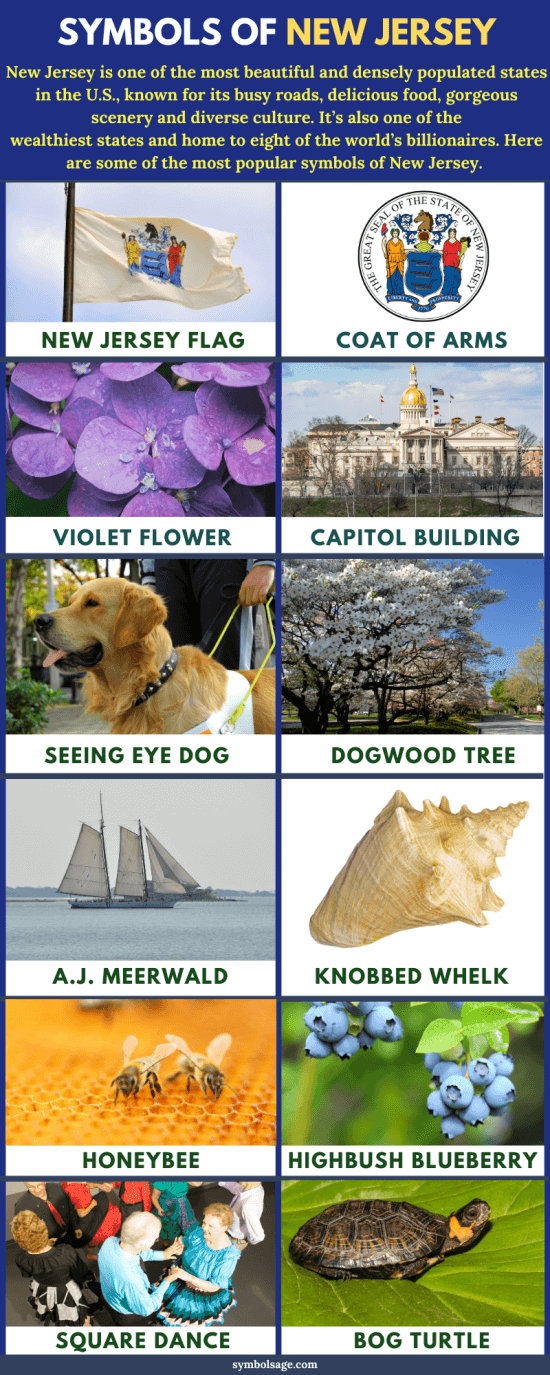
Table of Contents
New Jersey (NJ) is the third of the thirteen original U.S. states, admitted to the Union in December 1787. It’s one of the most beautiful and densely populated states in the U.S., known for its busy roads, delicious food, gorgeous scenery and diverse culture. It’s also one of the wealthiest states and home to eight of the world’s billionaires as mentioned in Forbes’ 33rd annual billionaire ranking.
In this article, we’re going to take a look at some of the state symbols of New Jersey. Some, like the square dance are official symbols of many other U.S. states as well whereas others like the A.J. Meerwald are unique to New Jersey.

The Flag of New Jersey
The state flag of New Jersey displays the state’s coat of arms in the centre of a buff-colored background. The coat of arms consists of the following symbols:
- A helmet on the shield’s crest: facing forward, it denotes sovereignty.
- The horse’s head (the state animal of New Jersey) above the helmet.
- Liberty and Ceres: Liberty (with the Phrygian cap on her staff) is a symbol of freedom and Ceres (the Roman goddess of grain), holding a cornucopia full of harvested produce, is a symbol of abundance.
- A banner reading: ‘Liberty and Prosperity’: the state motto of New Jersey.
The current design of the flag was adopted as the official state flag of New Jersey in 1896 and its colors, buff and dark blue (or Jersey blue), were chosen by George Washington for the state’s army regiments during the Revolutionary War.
State Seal of New Jersey
The design features the coat of arms surrounded by the words ‘THE GREAT SEAL OF THE STATE OF NEW JERSEY’.
In the original design, Liberty was depicted holding her staff in the crook of her right arm rather than in her right hand and both female figures, which now face forward, looked away from the shield in the centre. The cornucopia in Ceres’ hand was inverted with its open end on the ground but in the current version it’s held upright.
Modified and re-designed in 1777 by Pierre Eugene du Simitiere, the seal is also featured on the state flag of New Jersey and used on official documents and legislation.
Capitol Building New Jersey
The capitol building of New Jersey, known as the ‘New Jersey State House’ is situated in Trenton, the capital city of the state and the county seat of Mercer County. It’s the third-oldest state house in continuous legislative use in the U.S. The original building was completed in 1792, but several extensions were added shortly afterwards.
In 1885, a large portion of the State House was destroyed by fire after which it underwent extensive renovations. Since then, several sections were added to the building in different styles which give it its unique look. The capitol is open to the public and thousands of people visit it each year.
Violet Flower
The violet is a beautiful, delicate flower that’s commonly seen all over the lawns, meadows and fields of New Jersey in the spring. It has five petals which are mostly blue to purple.
There are also white ones with dark veins that radiate from the throat of the blossom. However, these are much less common. The leaves of these plants grow only at the plant’s base.
New Jersey adopted the violet as its official flower back in 1913, but it wasn’t until 1971 that the legislation was passed to specify this flower as the official flower of the state.
Seeing Eye Dog
Seeing Eye Dogs, known as guide dogs, are dogs that are trained to assist people who are visually impaired or blind by leading them. The breed of dog chosen for this service depends on its temperament and trainability.
Currently, Golden Retrievers, Poodles and Labradors are the most popular breeds selected by most service animal facilities in the U.S.A. Seeing Eye dogs are highly respected not only in the U.S.A, but throughout the world for the service they provide.
In January 2020, Governor Phil Murphy signed the legislation designating the Seeing Eye dog as the official state dog of New Jersey in January, 2020
Dogwood
The Dogwood tree (formerly known as the Whipple tree) is generally distinguished by its blossoms, distinctive bark and berries. These trees are mostly shrubs or deciduous trees and are extremely beautiful to look at when in full bloom.
Dogwood trees are native to North America and have been used throughout history for many purposes. The wood of the Dogwood tree is incredibly hard which is why it’s used for making daggers, loom shuttles, tool hands, arrows and many other items that require strong wood.
The Dogwood was designated the official memorial tree of the state of New Jersey in 1951 as a way of recognizing its immense value.
Square Dance
Since 1983, the official state American folk dance of New Jersey has been the Square Dance which is also the official dance of several 21 other U.S. states. It’s a social dance form with French, Scottish-Irish and English roots, performed by arranging four couples standing in a square formation with a couple on each side facing the middle. Square dance music is very lively and the dancers don colorful clothes. This form of dance gave the pioneers opportunities for recreation and social contact with their neighbors and even today the square dance is a popular way of socializing and having fun.
A.J. Meerwald Oyster Schooner
Launched in 1928, the A.J. Meerwald is an oyster schooner from Delaware Bay, built to cater to the needs of the oyster industry in New Jersey. It was one of hundreds of oyster schooners that were built along the Delaware Bay shore just before the shipbuilding industry declined which took place around the same time as the Great Depression.
The ship was added to the National Register of Historic Places in 1995 and was designated the official state tall ship of New Jersey three years later. It’s now a part of the Bayshore Center near Bivalve, New Jersey that offers unique, onboard educational programs.
The Knobbed Whelk
The knobbed whelk is a type of predatory sea snail that’s large in size, growing up to 12 inches. Its shell is mostly dextral, which means that it’s right-handed, and is especially thick and strong, with 6 clockwise coils on it. The surface has fine striations and knob-like projections. These shells are usually ivory colored or pale gray and the inside of the opening is orange.
Like conch shells, the knobbed whelk has been used by the North Americans throughout history as food and is also made into a bugle by cutting of the tip of its spire to form a mouthpiece. It’s native to North America and was named the official state shell of New Jersey in 1995.
The Honeybee
The honeybee is a flying insect that’s well known for its construction of colonial, perennial nests from wax. Honeybees live in large hives of up to 80,000 bees, each hive consisting of a queen bee, a little group of male drones and a vast majority of sterile female worker bees.
The younger bees are called ‘house bees’ and play a huge role in the maintenance of the hive. They construct it, care for the larvae and eggs, tend the drones and queen, regulate the temperature in the hive and defend it.
In 1974, a group of students from Sunnybrae School appeared at the New Jersey State House requested to have it designated as the official state bug of New Jersey and their efforts were successful.
Highbush Blueberry
Indigenous to New Jersey, highbush blueberries are extremely healthy, containing high fiber, vitamin C and antioxidants. They can also prevent cancer and heart disease. They were first commercially cultivated due to the pioneering work of Dr. Frederick Covile and Elizabeth White who dedicated themselves to the study, breeding and domestication of blueberries in Browns Mills, New Jersey.
Widely recognized as the ‘blueberry capital of the nation’, New Jersey ranks second in the U.S. in blueberry cultivation. Also called the ‘New Jersey blueberry’ the highbush blueberry was named the official state fruit of New Jersey in 2003.
The Bog Turtle
A critically endangered species, the bog turtle is the smallest of all North American turtles, growing only up to about 10 centimeters in length. The turtle’s head is dark brown or black and it has an orange, bright yellow or red spot on either side of its neck which makes it easy to identify. It’s a primarily diurnal turtle, meaning that it’s active during the day and sleeps at night.
Bog turtles have suffered a great deal from habitat loss, illegal collecting and pollution in New Jersey which has contributed to its declining population. It’s now an extremely rare reptile and measures are being taken to protect it. It was designated the official reptile of the state of New Jersey in 2018.
Check out our related articles on other popular state symbols:
Symbols of Hawaii
Symbols of Pennsylvania
Symbols of New York
Symbols of Texas
Symbols of California
Symbols of Florida








